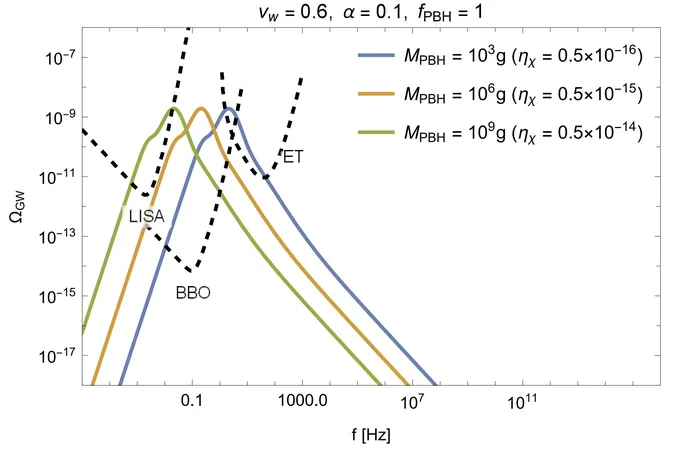
Are Gravitational Waves the Key to Understanding Black Holes and the Dark Matter Enigma?
2025-01-13
Author: Sarah
Recent advancements in our understanding of black holes could provide groundbreaking insights into the mysterious nature of dark matter. While conventional beliefs held that the quantum effects surrounding black holes were negligible—especially in the case of large black holes detected by gravitational wave observatories like LIGO—new theories suggest this might not be the whole story.
What is Hawking Radiation?
Hawking radiation is a theoretical prediction from quantum mechanics suggesting that black holes can emit energy in the form of radiation due to quantum fluctuations near the event horizon. This phenomenon occurs when virtual particle pairs are created; one falls into the black hole while the other escapes to become real particles. The escaping particles thus represent Hawking radiation. However, for heavy black holes, such as those detected in 2015, this radiation is almost undetectable due to their massive size.
A Surprising Twist in Quantum Effects
A recent discovery could revolutionize our understanding of black hole evaporation. The quantum memory burden effect posits that after a black hole loses half of its initial mass, its evaporation may stabilize instead of continuing. This stability arises because the energy states of information encoded within the black hole become more energetically favorable than those outside it. This stabilization process could have significant implications for understanding primordial black holes (PBHs) and their potential role as candidates for dark matter.
Types of Black Holes
In astrophysics, we recognize primarily two types of black holes: stellar-mass black holes (formed from the remnants of massive stars) and supermassive black holes (which reside at the centers of galaxies). However, primordial black holes are a hypothetical third type believed to have formed during the early universe and could range drastically in mass—from tiny black holes of a few grams to colossal ones of over 100,000 solar masses.
The Dark Matter Mystery
Dark matter is theorized to make up about 27% of the universe, but it has yet to be directly detected on Earth. Its invisible nature raises questions: If dark matter comprises particles, why haven't we encountered them? Alternatively, could dark matter exist in the form of compact objects, like PBHs, which would explain the lack of detection due to their low probability of collision with Earth?
Connecting the Dots
Could it be that dark matter is composed entirely of primordial black holes? This idea aligns with the behavior of PBHs; they interact solely through gravity, much like dark matter. Notably, the novel quantum memory burden effect suggests that PBHs could indeed fill the mass gap below what was previously assumed, opening new avenues for exploration.
Gravitational Waves: A Path to Confirmation
To validate this hypothesis, researchers aim to leverage gravitational waves (GWs), ripples in spacetime that can be produced by cataclysmic events. The ongoing research indicates that GWs can serve as a signature of PBH formation, especially those stabilized by the memory burden effect. My recent findings suggest that gravitational waves produced during the early universe could be detected in future experiments, especially in the range of 0.01–1 Hz, potentially by upcoming detectors like LISA and ET.
What Lies Ahead
Should the predicted gravitational wave patterns surface in forthcoming observations, they will not only validate the quantum memory burden effect but also strengthen the case for primordial black holes as the elusive dark matter. This discovery could fundamentally alter our understanding of the universe, merging the enigmatic concepts of black holes and dark matter into a cohesive narrative.
This unfolding saga in theoretical physics promises to unravel more mysteries, possibly reshaping our grasp of the cosmos as we know it. Stay tuned, as we navigate through these uncharted waters of space and time!
 Brasil (PT)
Brasil (PT)
 Canada (EN)
Canada (EN)
 Chile (ES)
Chile (ES)
 Česko (CS)
Česko (CS)
 대한민국 (KO)
대한민국 (KO)
 España (ES)
España (ES)
 France (FR)
France (FR)
 Hong Kong (EN)
Hong Kong (EN)
 Italia (IT)
Italia (IT)
 日本 (JA)
日本 (JA)
 Magyarország (HU)
Magyarország (HU)
 Norge (NO)
Norge (NO)
 Polska (PL)
Polska (PL)
 Schweiz (DE)
Schweiz (DE)
 Singapore (EN)
Singapore (EN)
 Sverige (SV)
Sverige (SV)
 Suomi (FI)
Suomi (FI)
 Türkiye (TR)
Türkiye (TR)
 الإمارات العربية المتحدة (AR)
الإمارات العربية المتحدة (AR)